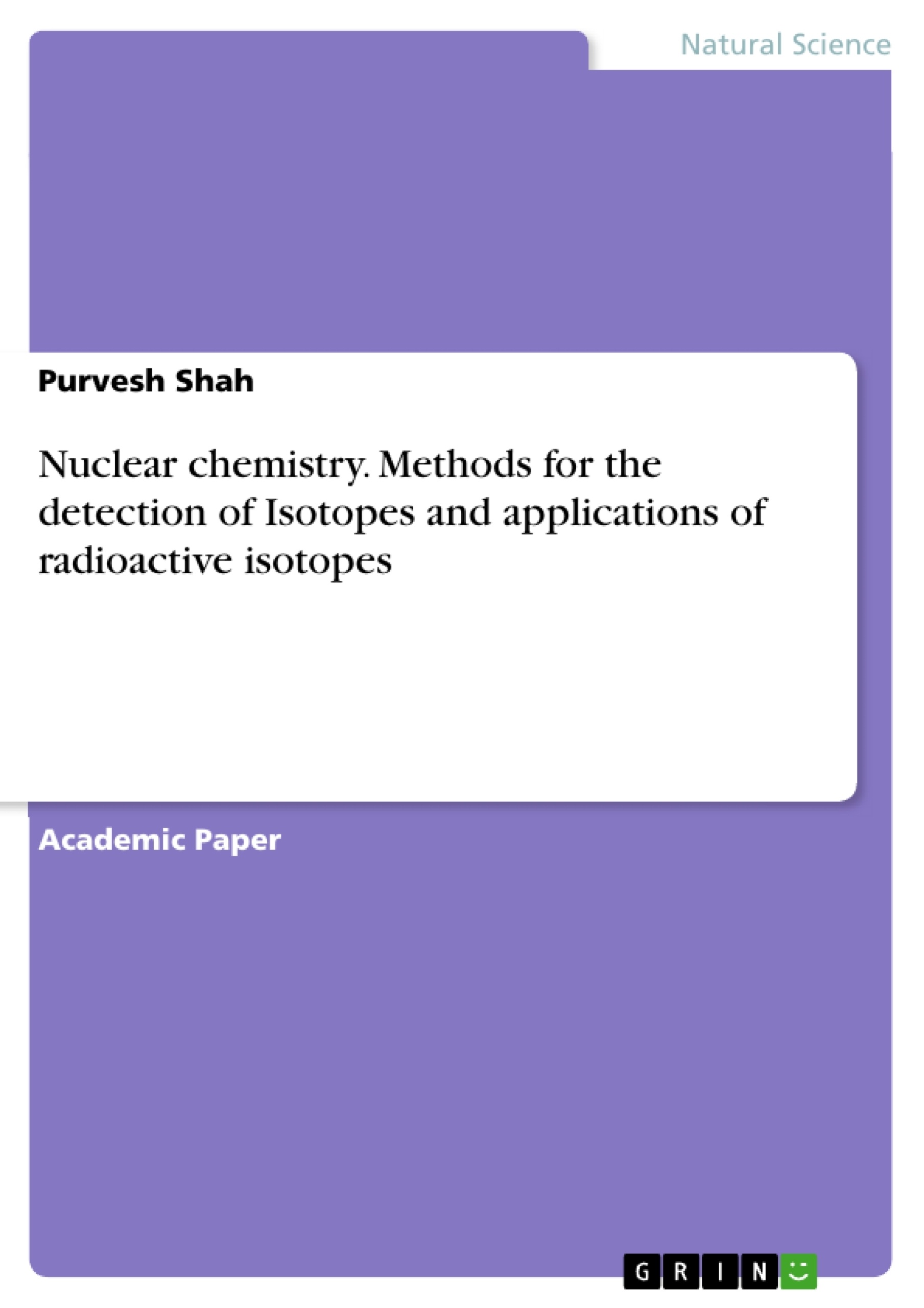This paper is about different aspects of nuclear chemistry. It deals with various methods for the detection of Isotopes and mainly focuses on Bainbridge velocity focusing mass spectrograph and Nier's double focusing mass spectrometer. In addition, applications of radioactive isotopes are analyzed. Different examples round off the paper.
Table of Contents
- Introduction
- Detection of isotopes
- Bainbridge velocity focusing mass spectrograph
- Nier's double focusing mass spectrometer
- Applications of Radioactive Isotopes
Objectives and Key Themes
The objective of this text is to introduce the fundamental concepts of nuclear chemistry, differentiating it from chemical reactions and focusing on nuclear transformations. It explores the detection of isotopes through mass spectrometry and highlights the applications of radioactive isotopes.
- Nuclear reactions vs. chemical reactions
- Isotope detection techniques (mass spectrometry)
- Nuclear transmutation
- Applications of radioactive isotopes
- Properties and characteristics of nuclides
Chapter Summaries
Introduction: This introductory chapter establishes the fundamental distinction between nuclear and chemical reactions. It emphasizes that nuclear reactions involve changes within the atomic nucleus, altering the number of protons and neutrons, leading to the formation of new elements through a process called transmutation. The chapter introduces key terminology such as nuclide, isotope, and radio nuclide, laying the groundwork for understanding subsequent discussions on isotopic detection and applications.
Detection of isotopes: This section delves into the methods used to detect isotopes, specifically focusing on two mass spectrographic techniques: Bainbridge velocity focusing mass spectrograph and Nier's double focusing mass spectrometer. The chapter likely details the principles, operation, and relative advantages of these instruments in resolving different isotopes based on their mass-to-charge ratios. The significance of this section lies in its explanation of how scientists can identify and quantify different isotopes within a sample, crucial for various applications in nuclear chemistry and related fields.
Applications of Radioactive Isotopes: This chapter explores the practical uses of radioactive isotopes, which are likely illustrated through examples detailed within the original text. The applications are likely diverse and could range from medical imaging and treatment to industrial processes and scientific research, highlighting the impact of nuclear chemistry on various domains. This section links theoretical concepts discussed earlier to their practical implications, demonstrating the real-world significance of nuclear chemistry.
Keywords
Nuclear chemistry, nuclear reactions, chemical reactions, transmutation, nuclide, isotope, radioisotope, mass spectrometry, Bainbridge mass spectrograph, Nier mass spectrometer, radioactive isotopes, applications of isotopes.
Frequently Asked Questions: A Comprehensive Language Preview of Nuclear Chemistry
What is the purpose of this text?
This text aims to introduce the fundamental concepts of nuclear chemistry, differentiating it from chemical reactions and focusing on nuclear transformations. It explores isotope detection using mass spectrometry and highlights the applications of radioactive isotopes.
What are the key themes covered?
Key themes include the differences between nuclear and chemical reactions, isotope detection techniques (specifically mass spectrometry), nuclear transmutation, applications of radioactive isotopes, and the properties of nuclides.
What methods of isotope detection are discussed?
The text focuses on two mass spectrographic techniques: the Bainbridge velocity focusing mass spectrograph and Nier's double focusing mass spectrometer. It likely details their principles, operation, and advantages in resolving isotopes based on their mass-to-charge ratios.
What is the significance of understanding isotope detection?
Understanding isotope detection is crucial because it allows scientists to identify and quantify different isotopes within a sample. This is essential for various applications in nuclear chemistry and related fields.
What are some applications of radioactive isotopes covered in the text?
The text explores the practical uses of radioactive isotopes, likely covering a range of applications, such as medical imaging and treatment, industrial processes, and scientific research. This section connects theoretical concepts to their real-world implications.
What is the difference between nuclear and chemical reactions?
The text establishes the fundamental distinction: nuclear reactions involve changes within the atomic nucleus, altering the number of protons and neutrons and leading to the formation of new elements (transmutation), unlike chemical reactions which involve changes in electron arrangements.
What key terms are defined in the text?
Key terms include: nuclear chemistry, nuclear reactions, chemical reactions, transmutation, nuclide, isotope, radioisotope, mass spectrometry, Bainbridge mass spectrograph, Nier mass spectrometer, radioactive isotopes, and applications of isotopes.
What is covered in the introduction chapter?
The introduction establishes the fundamental difference between nuclear and chemical reactions, introduces key terminology (nuclide, isotope, radionuclide), and lays the groundwork for understanding isotopic detection and applications.
What is discussed in the chapter on the detection of isotopes?
This section details the methods used to detect isotopes, focusing on the Bainbridge and Nier mass spectrometers, explaining their principles, operation, and advantages in separating isotopes based on their mass-to-charge ratios.
What does the chapter on the applications of radioactive isotopes cover?
This chapter explores the practical uses of radioactive isotopes across various fields, highlighting their impact and demonstrating the real-world significance of nuclear chemistry.
- Quote paper
- Purvesh Shah (Author), 2021, Nuclear chemistry. Methods for the detection of Isotopes and applications of radioactive isotopes, Munich, GRIN Verlag, https://www.grin.com/document/1127293




